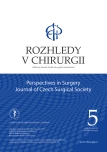-
Medical journals
- Career
Surgical treatment of cervical spine fractures in ankylosing spondylitis patients: posterior stabilization using intraoperative CT scanner-based navigation
Authors: P. Barsa; R. Fröhlich; J. Adamík; P. Suchomel
Authors‘ workplace: Neurochirurgické oddělení, Neurocentrum, Krajská nemocnice Liberec, a. s.
Published in: Rozhl. Chir., 2020, roč. 99, č. 5, s. 212-218.
Category: Original articles
doi: https://doi.org/10.33699/PIS.2020.99.5.212–218Overview
Introduction: The authors analyzed a series of ankylosing spondylitis patients with cervical spine fracture undergoing posterior stabilization using spinal navigation based on intraoperative CT imaging. The purpose of this study was to evaluate the accuracy and safety of navigated posterior stabilization and to analyze the adequacy of this method for treatment of fractures in ankylosed cervical spine.
Methods: Prospectively collected clinical data, together with radiological documentation of a series of 8 consecutive patients with 9 cervical spine fracture were included in the analysis. The evaluation of screw insertion accuracy based on postoperative CT imaging, description of instrumentation-related complications and evaluation of morphological and clinical results were the subjects of interest.
Results: Of the 66 implants inserted in all cervical levels and in upper thoracic spine, only 3 screws (4.5%) did not meet the criteria of anatomically correct insertion. Neither screw malposition nor any other intraoperative events were complicated by any neural, vascular or visceral injury. Thus we did not find a reason to change implant position intraoperatively or during the postoperative period. The quality of intraoperative CT imaging in our group of patients was sufficient for reliable trajectory planning and implant insertion in all segments, irrespective of the habitus, positioning method and comorbidities. In addition to stabilization of the fracture, the posterior approach also allows reducing preoperative kyphotic position of the cervical spine. In all patients, we achieved a stable situation with complete bone fusion of the anterior part of the spinal column and lateral masses at one year follow-up.
Conclusion: Spinal navigation based on intraoperative CT imaging has proven to be a reliable and safe method of stabilizing cervical spine with ankylosing spondylitis. The strategy of posterior stabilization seems to be a suitable method providing high primary stability and the conditions for a subsequent high fusion rate.
Keywords:
cervical spine – ankylosing spondylitis – spinal fractures – computer-assisted surgery – computed tomography
Sources
- Yilmaz N, Pence S, Kepekci Y, et al. Association of immune function with bone mineral density and biochemical markers of bone turnover in patients with anklylosing spondylitis. Int J Clin Pract. 2003;57(8):681−685.
- Kurucan E, Bernstein DN, Mesfin A. Surgical management of spinal fractures in ankylosing spondylitis. J SpineSurg. 2018;4(3):501−508. doi:10.21037/jss.2018.06.15.
- Reinhold M, Knop C, Kneitz C, et al. Spine fractures in ankylosing diseases: recommendations of the spine section of the German Society for Orthopaedics and Trauma (DGOU). Global Spine J. 2018;8(2 Suppl):56S−68S. doi:10.1177/2192568217736268.
- Vanek P, Votavova M, Ostry S, et al. Correction of kyphotic deformity of the cervical spine in ankylosing spondylitis using pedicle subtraction osteotomy of the seventh cervical vertebra. Acta Chir Orthop Traumatol Cech 2014;81(5):317−322.
- Navarro-Ramirez R, Lang G, Lian X, et al. Total navigation in spine surgery; a concise guide to eliminate fluoroscopy using a portable intraoperative computed tomography 3-Dimensional Navigation System World Neurosurg. 2017;100 : 325−335. doi:10.1016/j.wneu.2017.01.025.
- Guha D, Jakubovic R, Gupta S, et al. Spinal intraoperative three-dimensional navigation: correlation between clinical and absolute engineering accuracy. Spine J. 2017;17(4):489−498. doi:10.1016/j.spinee.2016.10.020.
- Einsiedel T, Schmelz A, Arand M, et al. Injuries of the cervical spine in patients with ankylosing spondylitis: experience at two trauma centers. J Neurosurg Spine 2006;5(1):33–45. doi:10.3171/spi.2006.5.1.33.
- El Tecle NE, Abode-Iyamah KO, Hitchon PW, et al. Management of spinal fractures in patients with ankylosing spondylitis. Clin Neurol Neurosurg. 2015; 139 : 177–182. doi:10.1016/j.clineuro.2015.10.014.
- Yan L, Luo Z, He B, et al. Posterior pedicle screw fixation to treat lower cervical fractures associated with ankylosing spondylitis: a retrospective study of 35 cases. BMC Musculoskeletal Disord. 2017;18(1):81–81. doi:10.1186/s12891-017-1396-5.
- Laerch TJ, Massie JB, Pathria MN, et al. Assessment of pedicle screw placement utilizing conventional radiography and computed tomography: a proposed systematic approach to improve accuracy of interpretation. Spine 2004;29(7):767–773. doi: 10.1097/01.brs.0000112071.69448.a1
- Wiesner L, Kothe R, Schulitz KP, et al. Clinical evaluation and computed tomography scan analysis of screw tracts after percutaneous insertion of pedicle screws in the lumbar spine. Spine 2000;25(5):615–621. doi:10.1097/00007632-200003010-00013.
- Rienmuller A, Buchmann N, Kirschke JS, et al. Accuracy of CT-navigated pedicle screw positioning in the cervical and upper thoracic region with and without prior anterior surgery and ventral plating. Bone Joint J. 2017;99-B(10):1373–1380. doi:10.1302/0301-620X.99B10.BJJ-2016-1283.R1.
Labels
Surgery Orthopaedics Trauma surgery
Article was published inPerspectives in Surgery

2020 Issue 5-
All articles in this issue
- Management of oesophageal anastomosis dehiscence after oesophagectomy for oesophageal cancer
- Early complications in surgery of umbilical and epigastric hernias
- Surgical treatment of cervical spine fractures in ankylosing spondylitis patients: posterior stabilization using intraoperative CT scanner-based navigation
- Upper urinary tract urothelial carcinomas – our experience
- “Maximal” minimally invasive thymectomy in patients with Nonthymomatous Myasthenia Gravis – short-term results over a 10year period – retrospective study
- Abdominal abscess associated with salmonellosis − case report
- Aorto-caval fistula – case report
- Covidí příležitost
- Perspectives in Surgery
- Journal archive
- Current issue
- Online only
- About the journal
Most read in this issue- Early complications in surgery of umbilical and epigastric hernias
- Upper urinary tract urothelial carcinomas – our experience
- Management of oesophageal anastomosis dehiscence after oesophagectomy for oesophageal cancer
- Abdominal abscess associated with salmonellosis − case report
Login#ADS_BOTTOM_SCRIPTS#Forgotten passwordEnter the email address that you registered with. We will send you instructions on how to set a new password.
- Career

